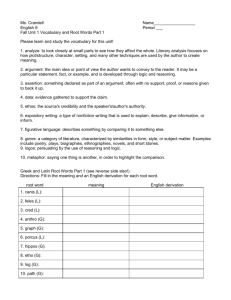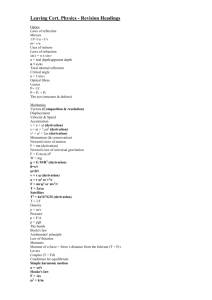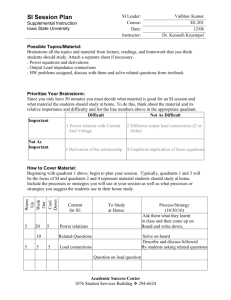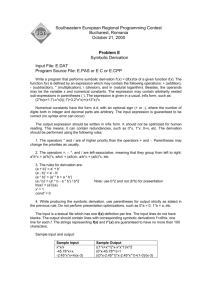File
advertisement
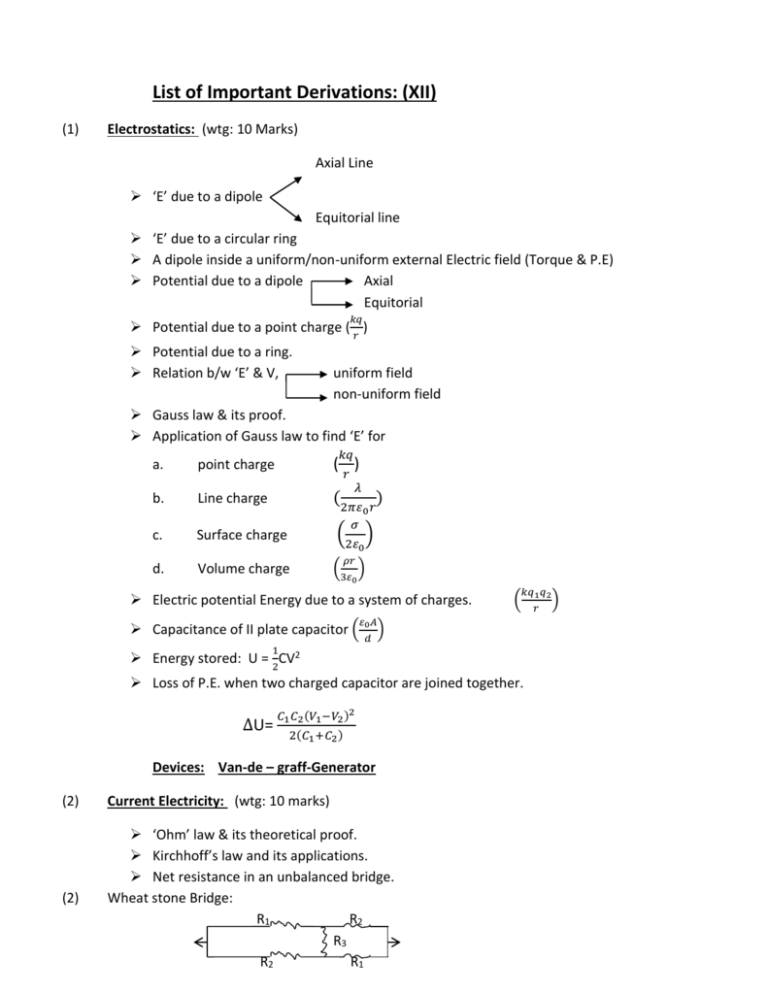
List of Important Derivations: (XII)
(1)
Electrostatics: (wtg: 10 Marks)
Axial Line
‘E’ due to a dipole
Equitorial line
‘E’ due to a circular ring
A dipole inside a uniform/non-uniform external Electric field (Torque & P.E)
Potential due to a dipole
Axial
Equitorial
𝑘𝑞
Potential due to a point charge ( 𝑟 )
Potential due to a ring.
Relation b/w ‘E’ & V,
uniform field
non-uniform field
Gauss law & its proof.
Application of Gauss law to find ‘E’ for
𝑘𝑞
a.
point charge
( )
b.
Line charge
(
c.
Surface charge
(2𝜀 )
d.
𝑟
𝜆
2𝜋𝜀0 𝑟
𝜎
)
0
Volume charge
𝜌𝑟
(3𝜀 )
0
Electric potential Energy due to a system of charges.
𝜀0 𝐴
Capacitance of II plate capacitor (
𝑑
𝑘𝑞1 𝑞2
(
)
1
Energy stored: U = 2CV2
Loss of P.E. when two charged capacitor are joined together.
∆U=
𝐶1 𝐶2 (𝑉1 −𝑉2 )2
2(𝐶1 +𝐶2 )
Devices: Van-de – graff-Generator
(2)
Current Electricity: (wtg: 10 marks)
(2)
‘Ohm’ law & its theoretical proof.
Kirchhoff’s law and its applications.
Net resistance in an unbalanced bridge.
Wheat stone Bridge:
R1
R2
R3
R2
R1
𝑟
)
R=
2𝑅1 𝑅2 +𝑅3 (𝑅1 +𝑅2 )
𝑅1 +𝑅2 +2𝑅3
Series combination of cells : I =
𝑛𝐸
𝑅+𝑛𝑟
Parallel combination of cells: I =
Derivation of
Devices:
𝑛𝐸
𝑛𝑅+𝑟
𝐸
𝐸
( 1+ 2)
𝑟1 𝑟2
Enet = 1 1
+
𝑟1 𝑟2
1. Potentiometer.{to find E1/E2 & to find internal res.of a cell.
2. Meten Bridge
3.
Magnetism : (Wtg: 10 Marks)
‘B’ due to a straight wire.
B=
𝜇0 I
4𝜋 𝑎
[ Sin∅1 + Sin∅2 ]
‘B’ due to a circular of ring & straight current carrying wire.
Ampere’s(Regular & irregular path) circuital law and its proof.
Application of ampere circuital law
‘B’ due to straight wire
Solenoid
B= 𝜇onI
Totroid
Force on a current carrying wire and on a moving change.
Mutual force b/w two parallel wires.
Torque experienced by a current carrying coil palced inside a uniform external magnetic
field: ; Torque = NIAB Sin𝜃
𝜇𝑟 = 1 + 𝑥𝑚
Torque on a Bar-Magnet (Magnetic dipole) inside a uniform external field.
P.E. of a dipole.
Relation b/w true dip and apparent dip and apparent dip.
Devices:
(3)
(1)
Cyclotron
(2)
Moving coil Galvanometer and its conversion to A & V
EMI, A.C
Motional Emf in a moving rod 𝜀 = -Blv.
Motional Emf of a rotating rod 𝜀 = ½ Bl2w.
Self inductance of a long solenoid.
Mutual inductance of two solenoid.
1
Magnetic energy stored in a coil U = 2 LI2
Eav =
2𝜀0
Erms =
𝜋
𝜀0
√2
and Iav =
, Irms =
√2
Pure resistive
Pure Inductive
Pure capacitive
RC Circuit
LC Circuit
LR Circuit
LCR Circuit
Variation of
impendence
with frequency
of applied AC
source.
Devices:
(4)
𝜋
𝐼0
A.C Circuits
2𝐼0
Phasor diagram
Average power loss in an AC circuit Pav = Irm Vrm Cos∅.
Q-factor.
Resonance and its applications.
(1)
AC Generator
(2)
Transformer.
Ray Optics:
1
Mirror Formula 𝑓 =
1
1
𝑣
+ 𝑢, m= − 𝑢
𝑣
Refraction at spherical surface:
𝜇1
𝑣
𝜇1
𝑣
−
𝜇2
−
𝑢
𝜇2
𝑢
=
=
𝜇2 −𝜇1
For Both convex
& concave
surfaces.
𝑅
𝜇1 −𝜇2
𝑅
Real and apparent-depth.
𝑡
Lateral shift d= cos 𝑟 sin(𝑖 − 𝑟)
lens makes formula: & its application
1
𝜇2
1
1
= ( − 1) ( − )
𝑓
𝜇1
𝑅1 𝑅2
1
Combination of lenses
Lens formula:
1
𝑓
1
=𝑣−
𝛿𝑚 = (𝜇 -1)A, 𝜇 = sin
1
1
1
𝑓2
(𝑓 = 𝑓 +
1
𝑣
, m=𝑢
𝑢
(𝛿𝑚+𝐴)
2
)
𝐴
/𝑠𝑖𝑛 2 , 𝛿 + A = I + e.
Magnifying power of microscope.
Simple:
m = 1 + D/fe.
compound:
𝑣
𝐷
m = 𝑢0 (1 + 𝑓 )
0
𝑒
Magnifying power of Telescope:
At LDDV:
𝑓
𝑓
m = 𝑓0 (1 + 𝐷𝑒)
𝑒
𝑓
for normal vision m = 𝑓0
𝑒
Devices:
(1)
Astromical & Terrestrial
Telescope
Reflecting
(2)
(3)
Microscope
Eyes.
Simple & compound.
Wave optics
Intensity I = a2 + b2 + 2abcos∅,
∅ = 2n𝜋
Maximum
𝐷𝜆
∅ = (2𝑛 − 1) 2𝑑
YDSE: Derivation of
yn =
&
Minimum
𝐷𝑛𝜆
Maximum n= 0,1,2,--------
𝑑
𝐷𝜆
yn = (2n-1)2𝑑
Minimum n= 1,2,3, -----------
Relation b/w intensity maxima and intensity at a general point on the screen: i.e.
I = I0 Cos2∅/2 ,
SLDE:
∅
Phase diff. b/w maxima pt. & genera point on the screen.
Derivation of
yn-1 = (2n-1)
yn =
Derivation of
2𝑑
Maxima, n≠0, n≠1, n= 2,3,--------
𝐷𝑛𝜆
Minima, n≠ 0, n=1,2,3-----------
𝑑
2𝜇𝑠𝑖𝑛𝜃
Resolving power of microscope:
Resolving power of Telescope Rp =
𝐷𝜆
Rp = ( 1.22𝜆 )
𝐷
1.22𝜆
Malus law I=I0cos2𝜃
Brewster Law: 𝜇 = tan ip
(6)
Atomic Nucleus:
Bohr model & Derivation of vn , rn & En of an electon revolving in nth orbit of a H & H-like
atom.
1
1
1
Derivation of 𝛾 = 𝜆 = Ry Z2 (𝑛2 − 𝑛2 )
𝑖
𝑓
Ry = Rydberg constant.
Binding Energy B.E = (∆𝑚) c2, ∆𝑚 = mass defect.
for numerical case: B.E. = ∆𝑚 (amu) x 931.5 Me
Derivation of T1/2 =
1
{tav = 𝜆 &
(7)
0.693
, N= N0e-λt, A=A0 e-λt
𝜆
𝑁
𝑁0
=
𝐴
𝐴0
1 𝑛
= (2) , n= 𝑇
𝑡
1/2
}
Dual Nature:
λ=
12.27𝐴0
𝜆
Davission – Germen Experiment.
Photo- electric effect.
1243
Vs = 𝜆(𝑛𝑚) 𝑒𝑣 − 𝑤0 (𝑒𝑣)
(8)
Semiconductors:
Energy-Band Theory & difference b/w metals semiconductors and insulator on the basis of
Energy-bands.
Formation of N-types and P-type semiconductors.
Forward & Reverse bias characteristics of Jn. diode.
Application of Jn. diodes.
Half & full wave rectifier
LED & Photo diodes
Solar cells
Zener diodes
IB
Jn-transister: Formation & its type
Transister action.
Input
CE-transister characterstic
VBE
Output.
Transistor parameter 𝛼, 𝛽, 𝐴𝑣 ,gm & their interrelation.
Transistor as
a switch
pnp
an amplifier
an Oscillator
npn
Logic Gates: NOT, OR, AND, NAND, NOR, X-OR symbols, Truth Tables and mathematical
expressions.
(9)
P.O.C.:
Modulation & its need.
Circuit of AM and its demodulation.
Band-width of different modes of communication & different channels.
Ground-wave, sky wave & satellite communication.
Optical communication (Qualitative ideas only).
